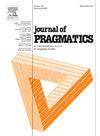在一个听者意义的模型中捍卫说话者的意图
IF 1.7
1区 文学
0 LANGUAGE & LINGUISTICS
引用次数: 0
摘要
Hansen和Terkourafi对传统的意义模型提出了一个令人信服的挑战,该模型认为说话者的意图是交际成功的主要决定因素。他们提出的替代模型以听者的解释为中心,使说话人的意图在理论上是多余的,这对以意图为中心的方法提供了有价值的纠正。虽然我们同意Hansen和Terkourafi对传统意义模型过度依赖说话者意图的普遍批评,但我们在他们的论证中发现了三个局限性。首先,他们的批评依赖于一种不必要的限制性概念,即意图是一种不透明的、内在难以接近的精神状态。其次,心理学和文化研究的现有研究为意图不可接近的说法提供了有力的反证。第三,他们所引用的关于说话人意图在区分“所说”和“所意”方面的不确定性的证据可以被重新解释,以强调说话人意图的重要性。此外,我们认为说话人的意图在塑造听者的解释中起着至关重要的作用,特别是在考虑会话角色时。综上所述,我们认为一个全面的意义模型需要整合说话者和听者的角色,认识到他们在交际过程中的相互依存关系。本文章由计算机程序翻译,如有差异,请以英文原文为准。
Defending speaker intention in a model of the hearer's meaning
Hansen and Terkourafi present a compelling challenge to traditional models of meaning that privilege speaker intention as the primary determinant of communicative success. Their proposed alternative model, which centers on the hearer's interpretation while rendering speaker intention theoretically redundant, offers a valuable corrective to intention-centric approaches. While we concur with Hansen and Terkourafi's general critique of traditional models of meaning as overly reliant on speaker intention, we identify three limitations in their argumentation. First, their critique relies on an unnecessarily restrictive conceptualization of intention as an opaque and inherently inaccessible mental state. Second, existing research in both psychological and cultural studies provides robust counterevidence to claims about intention's inaccessibility. Third, the very evidence they cite regarding the indeterminacy of speaker intention in distinguishing “what is said” from “what is meant” can be reinterpreted to underscore the significance of speaker intention. Furthermore, we maintain that speaker intention plays a crucial role in shaping the hearer's interpretation, particularly when it comes to accounting for conversational roles. In conclusion, we argue that a comprehensive model of meaning needs to integrate both the speaker’s and the hearer’s roles, recognizing their interdependence in the communicative process.
求助全文
通过发布文献求助,成功后即可免费获取论文全文。
去求助
来源期刊

Journal of Pragmatics
Multiple-
CiteScore
3.90
自引率
18.80%
发文量
219
期刊介绍:
Since 1977, the Journal of Pragmatics has provided a forum for bringing together a wide range of research in pragmatics, including cognitive pragmatics, corpus pragmatics, experimental pragmatics, historical pragmatics, interpersonal pragmatics, multimodal pragmatics, sociopragmatics, theoretical pragmatics and related fields. Our aim is to publish innovative pragmatic scholarship from all perspectives, which contributes to theories of how speakers produce and interpret language in different contexts drawing on attested data from a wide range of languages/cultures in different parts of the world. The Journal of Pragmatics also encourages work that uses attested language data to explore the relationship between pragmatics and neighbouring research areas such as semantics, discourse analysis, conversation analysis and ethnomethodology, interactional linguistics, sociolinguistics, linguistic anthropology, media studies, psychology, sociology, and the philosophy of language. Alongside full-length articles, discussion notes and book reviews, the journal welcomes proposals for high quality special issues in all areas of pragmatics which make a significant contribution to a topical or developing area at the cutting-edge of research.
 求助内容:
求助内容: 应助结果提醒方式:
应助结果提醒方式:


